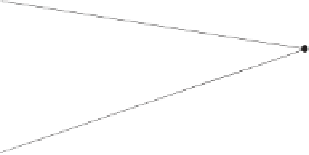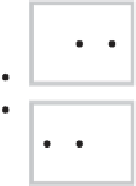Graphics Programs Reference
In-Depth Information
in London on his discoveries has been published and became the first milestone in the
history of this topic. In this lecture, he describes how his discovery came about as a result
of his acoustical experiments. Wheatstone also developed the first stereoscopic viewer,
which worked with mirrors. Initially, a pair of stereo pictures had to be drawn by hand,
but with the invention of photography by Louis Daguerre in 1839, it became possible to
generate precise pairs of stereo pictures and watch them as a single stereoscopic image.
The ideal graphics output device should be three-dimensional. Unfortunately, only
a few such devices are available today and they are expensive and cumbersome. This
is why stereo pictures, displayed on a two-dimensional screen or printed on paper, are
interesting and have important applications. The reason we see real-life objects in three
dimensions is that our eyes are separated (by about 60-70 mm) and hence look at the
same object from slightly different positions (Figure 3.41a). They see slightly different
images, which are “fused” by the brain to create the three-dimensional image.
The principle of stereo images is therefore to create and display two slightly different
images of the same object and to make sure that each eye sees just one image. This
may be achieved by displaying the two images in two different colors and watching them
through special glasses that allow each color to reach just one eye. Other methods for
viewing such a pair of images in stereo are discussed in Section 3.13.
left eye
left
eye
P
*
left
P
*
A
B
k
A
z
B
P
right
right
AB
x
eye
right eye
(a)
(b)
Figure 3.41: Principle of Stereo Images.
The simplest way to calculate the two stereo images is to use translation and
perspective projection. This is what makes stereoscopy a useful application of the
concepts described earlier. Figure 3.41b shows each eye as a viewer. The left eye is
located at (
k
). To create the image seen by the
left eye (the projection
P
left
of point
P
), we first have to translate the eye to the origin
and then follow with a standard perspective projection. The transformations are
−
e,
0
,
−
k
)andtherightoneat(
e,
0
,
−
⎛
⎞
⎛
⎞
⎛
⎞
1000
0100
0010
e
1000
0100
000
r
0001
1000
0100
000
r
e
⎝
⎠
⎝
⎠
⎝
⎠
=
=
T
left
.
001
001

























Search WWH ::

Custom Search